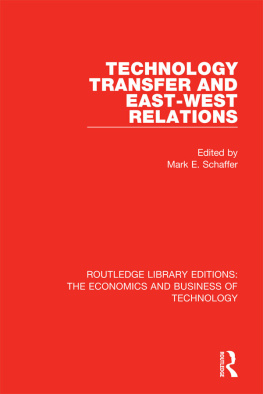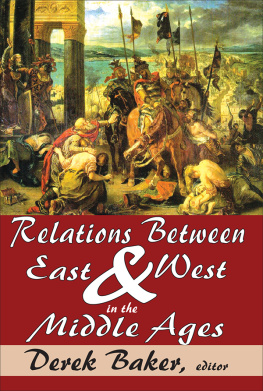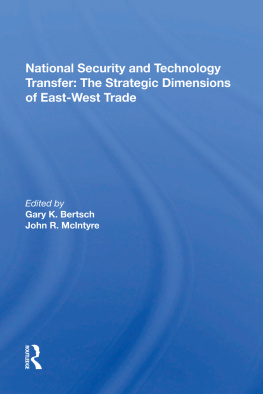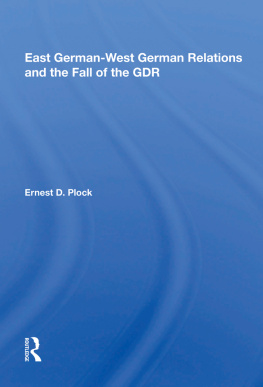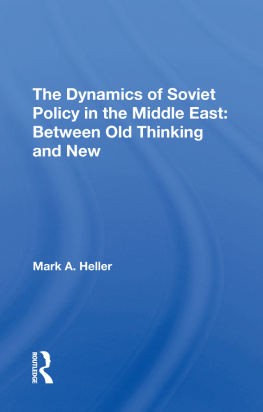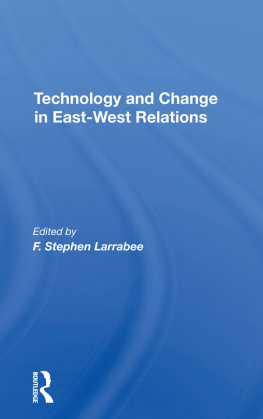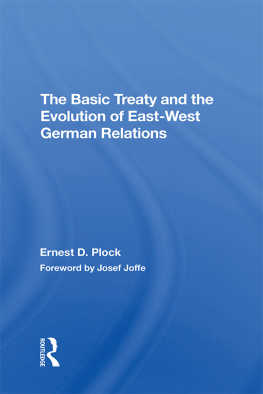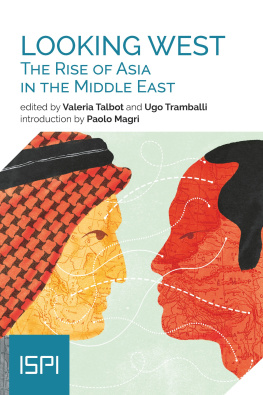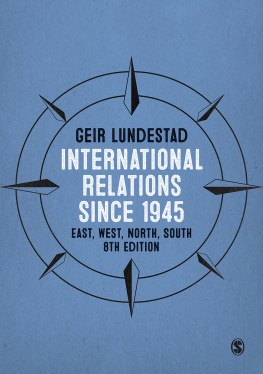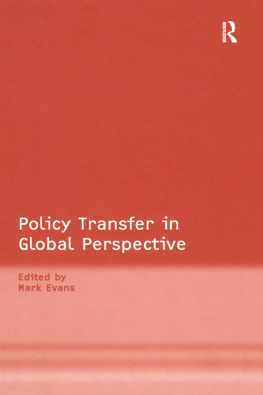ROUTLEDGE LIBRARY EDITIONS: THE ECONOMICS AND BUSINESS OF TECHNOLOGY
Volume 45
TECHNOLOGY TRANSFER AND EAST-WEST RELATIONS
TECHNOLOGY TRANSFER AND EAST-WEST RELATIONS
Edited by
MARK E. SCHAFFER
First published in 1985 by Croom Helm
This edition first published in 2018 by Routledge
2 Park Square, Milton Park, Abingdon, Oxon OX14 4RN
and by Routledge
711 Third Avenue, New York, NY 10017
Routledge is an imprint of the Taylor & Francis Group, an informa business
1985 Millenium Publishing Group
All rights reserved. No part of this book may be reprinted or reproduced or utilised in any form or by any electronic, mechanical, or other means, now known or hereafter invented, including photocopying and recording, or in any information storage or retrieval system, without permission in writing from the publishers.
Trademark notice: Product or corporate names may be trademarks or registered trademarks, and are used only for identification and explanation without intent to infringe.
British Library Cataloguing in Publication Data
A catalogue record for this book is available from the British Library
ISBN: 978-1-138-50336-6 (Set)
ISBN: 978-1-351-06690-7 (Set) (ebk)
ISBN: 978-0-8153-6027-8 (Volume 45) (hbk)
ISBN: 978-1-351-11810-1 (Volume 45) (ebk)
Publishers Note
The publisher has gone to great lengths to ensure the quality of this reprint but points out that some imperfections in the original copies may be apparent.
Disclaimer
The publisher has made every effort to trace copyright holders and would welcome correspondence from those they have been unable to trace.
Technology
Transfer
and East-West
Relations
EDITED BY MARK E. SCHAFFER
CONTENTS
1985 Millennium Publishing Group
Croom Helm Ltd, Provident House, Burrell Row,
Beckenham,Kent BR3 1AT
Croom Helm Australia Pty Ltd, First Floor,
139 King Street, Sydney, NSW 2001,Australia
British Library Cataloguing in Publication Data
Technology transfer and East-West relations.
1. Technology transfer 2. Technology transfer
Communist countries
I. Schaffer, Mark E.
338.91091717 1T174.3
ISBN 0-7099-3325-8
Printed and bound in Great Britain by Biddles Ltd, Guildford and Kings Lynn
The Growth Path of a Latecomer in the Course of Technological Catching-up
Comparison of OECD Exports of Investment Goods to the Eastern Countries with Eastern Countries Imports from the Rest of the World
Eastern-reported Capital Goods Imports of Eastern Europe and the Soviet Union, by Region or Origin
End-use Sector and Industrial Branch Distribution of Eastern Countries Capital Goods Imports from the West
Comparison of Intra-CMEA Imports and Exports of Capital Goods
Relationship Between OECD Investment Goods Exports to the Eastern Countries and Gross Fixed Investment
Soviet Imports of Western Machinery and Equipment
Machinery and Transport Equipment Exports to the USSR from OECD Member Countries
Soviet Imports of Western Machinery and Domestic Investment
Structure of Soviet Imports of Machinery and Equipment
Share of Soviet Imports of Machinery and Equipment from Developed Capitalist Countries
Microelectronic Equipment and Technology Legally and Illegally Acquired by the Soviet Bloc
Ratio of Exports to Imports for the Trade of Machinery and Chemicals with a High Research Intensity by the Developed Western Countries
Technology Content in the Export of Machinery to the European Community Countries
Aggregate and TNC-related Performance in 25 US Industries in the Period 196670, by R&D Intensity Class
This volume originates in the 1983 Millennium Conference on Technology Transfer and East-West Relations in the 80s, sponsored by Millennium: Journal of International Studies and held at the London School of Economics and Political Science. The Journal would like to thank the United States Embassy in London, the Department of International Relations at the LSE, and the School itself for their support of the conference. Some of the editing, and the writing of the Introduction, took place while the Editor was a US National Science Foundation Graduate Fellow. Any opinions, findings or recommendations expressed in this volume are those of the Editor and authors and do not necessarily reflect the views of Millennium: Journal of International Studies, the London School of Economics, the United States Embassy in London, or the US National Science Foundation.
For their participation in the conference, their efforts and advice in its organisation, their suggestions for this volume, and/or their helpful comments on the material presented in the Editors Introduction, I would like to thank in particular Julian Cooper, Paul David, Matthew Evangelista, Carla Garapedian, Stanislaw Gomulka, Agota Gueullette, Malcolm Hill, Mark J. Hoffman, David Holloway, Hugh Macdonald, James Mayall, Lois Winner Mervyn, Robert Nurick, Hilary Parker, Iris Portny, Edward Rhodes, Susan Strange, Gautam Sen, Alexander Vershbow, Peter Wiles, Stephen Woolcock, Michael Yaffe, the participants in the strategic studies seminar of the LSE International Relations Department, the Management and Editorial Boards of Millennium: Journal of International Relations. and the speakers and panelists at the 1983 Millennium Conference.
MES London
Mark E. Schaffer
This volume is a comprehensive survey of technology transfer from West to East and its place within East-West relations. The subject cuts across the traditional boundaries of a number of academic disciplines, and this survey therefore examines the economic, political, strategic and legal aspects of West-East technology transfer.
The starting point of the book is the causes and implications of the technological gap between East and West, and the nature of innovation in the Eastern economies. Among the major questions addressed are whether the deficiencies of the innovation process in the East are inherent in the system of central planning, and what kind of economic reform, if any, could remedy these problems. A related set of questions discussed below concerns the role of Western technology in Eastern economic growth. The size and structure of West-East technology transfer, and the relative economic importance to the Eastern economies of the various forms of this transfer, are both examined. The economic importance of trade in technology to the Western economies, and the experience of Western firms in this trade, are also analysed in detail.
One consequence of the adversarial relationship between East and West is that the West has sought to control the West-East transfer of technology which is believed could effect the military balance. But Western governments have also sought to influence West-East technology transfer for other reasons, such as influencing the behaviour of the Soviet Union or achieving economic gains through increased exports to the East. The attempted influence and control of West-East technology transfer by Western governments raises a host of interrelated questions addressed by the contributors to this volume. Clearly the structure of this transfer and its economic and military importance to the East have powerful implications for its direction by Western governments towards political or economic ends. On the other hand, the political environment has had a considerable influence on the course of West-East technology transfer, which in turn has caused economic and political repercussions felt by both West and East. Western policies on West-East technology transfer have also been the source of major disagreements within the Atlantic alliance. Both these policies and the disagreements have important legal aspects which are also discussed below. Finally, the contributions to this survey discuss important problems which go beyond the subject of West-East technology transfer: in particular, the conduct of economic relations between military adversaries, and the conflict between the control of information by the State and the maintenance of an open society.



